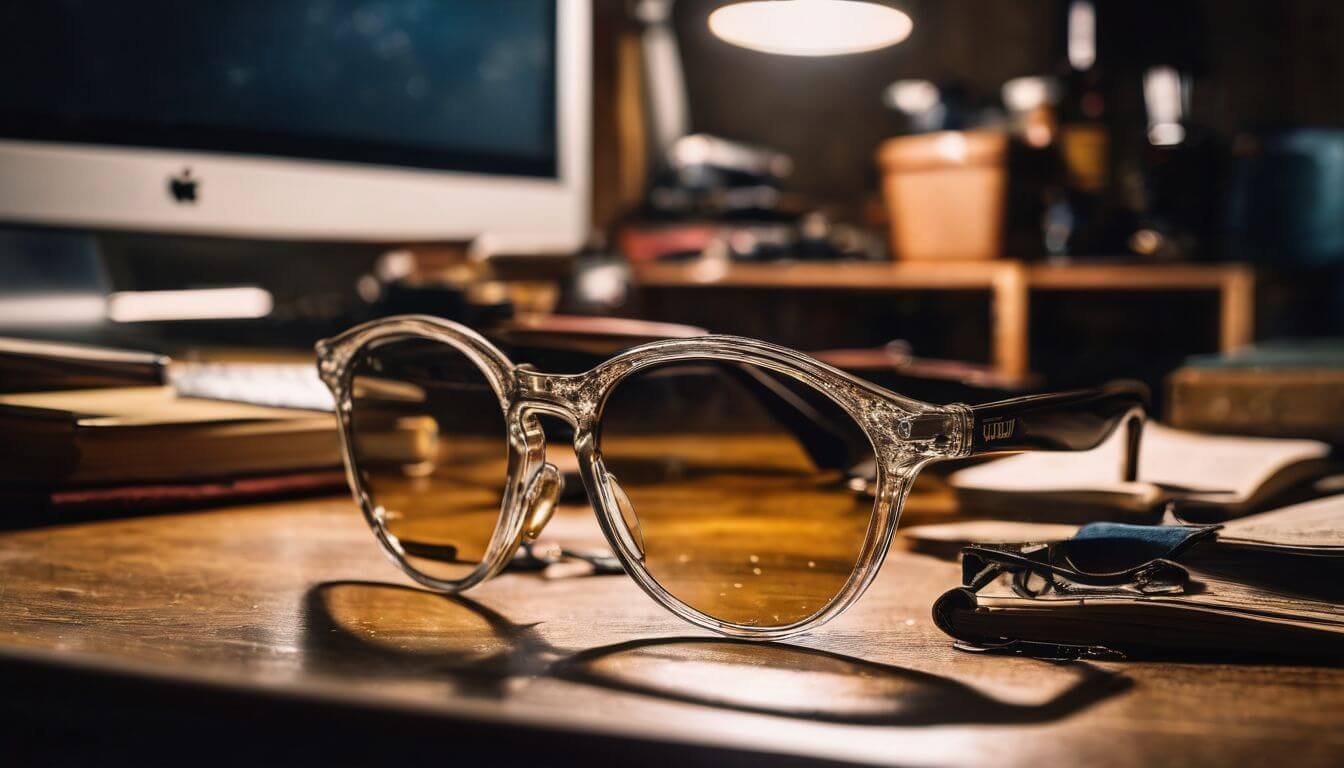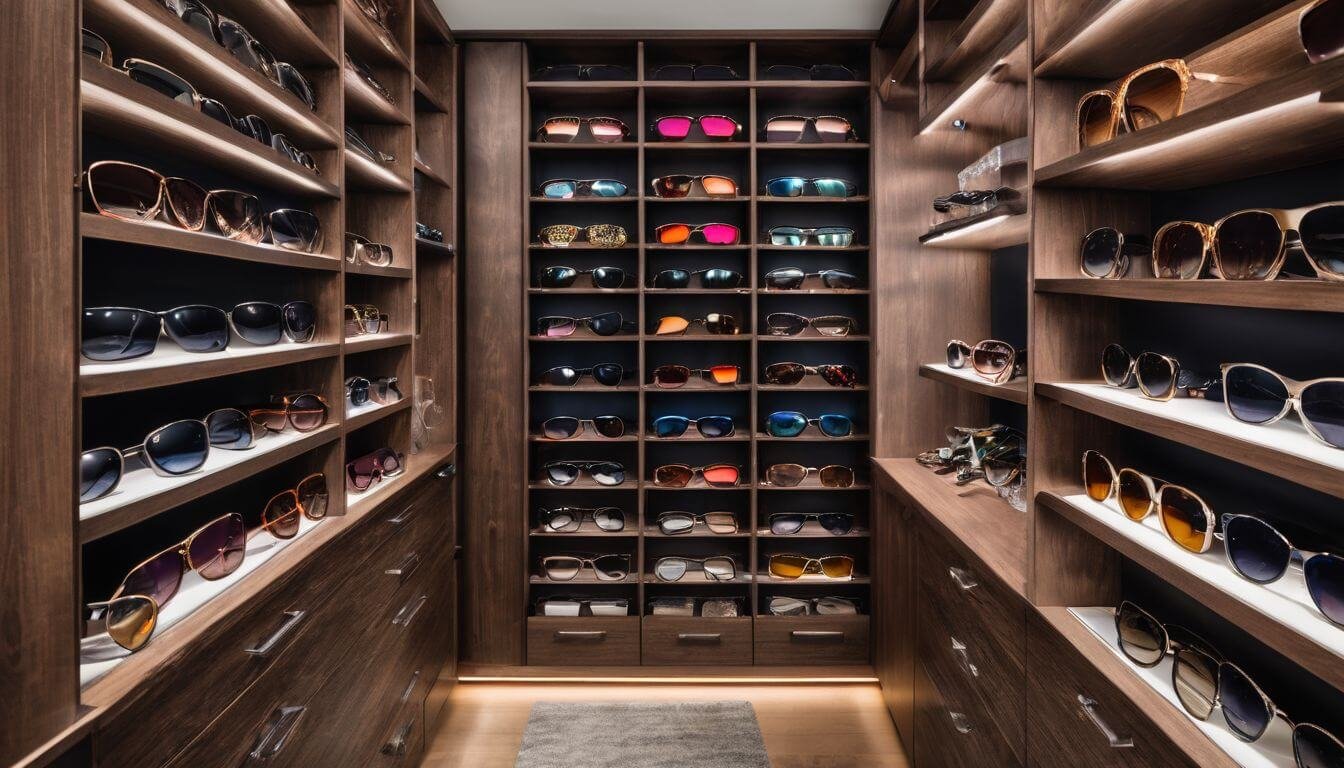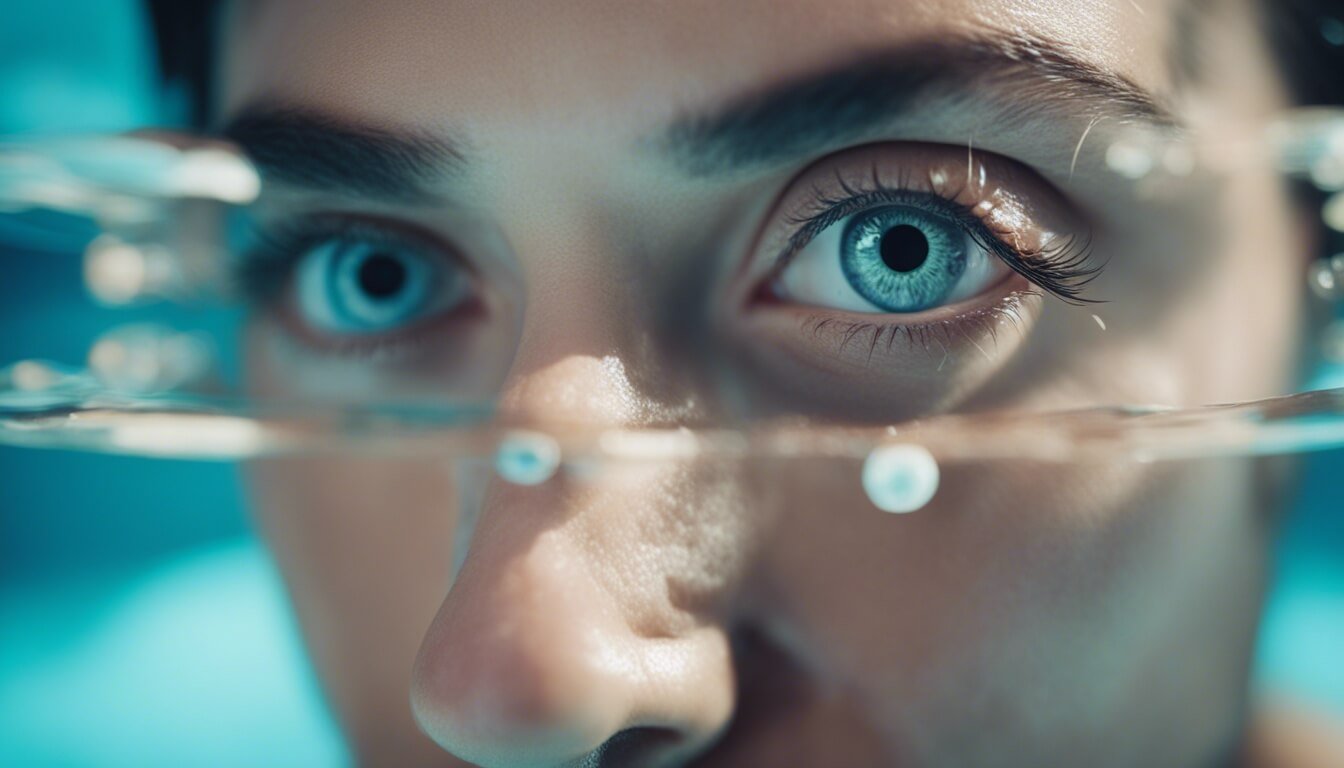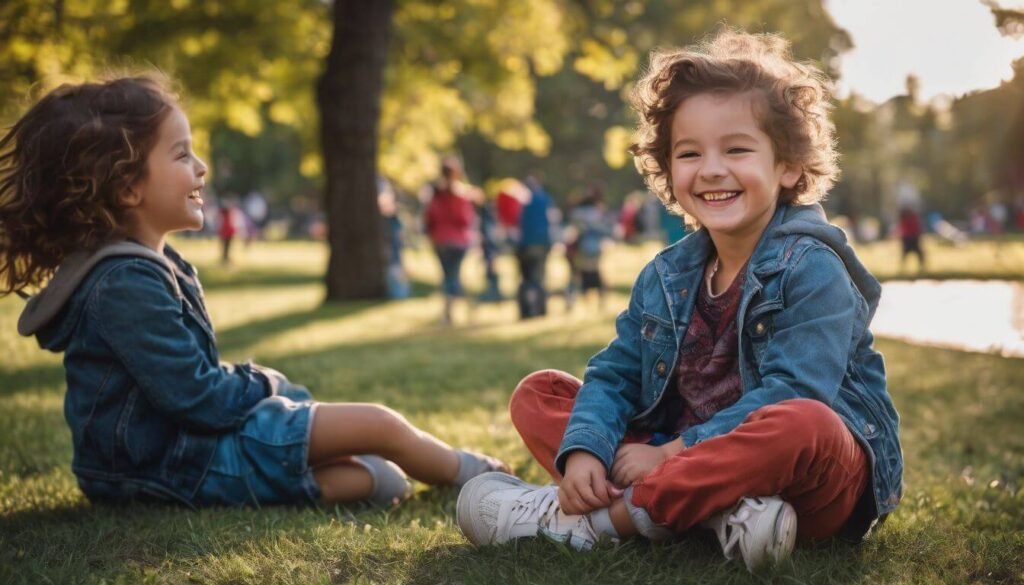
How Old Do You Have to Be to Wear Contacts? Expert Guidelines Revealed
Wondering when’s the right time for your kiddo to switch from glasses to contacts? You’re not alone – parents often puzzle over this big vision decision. Believe it or not, children as young as eight can successfully sport contact lenses! This guide is your trusty sidekick, packed with info to determine if your child is ready for contact-lens life.
Dive in – we’ve got the lowdown you need!
Key Takeaways
- Kids can wear contact lenses as young as eight, but they need to show they can take good care of them.
- Daily disposable lenses are easy for children because there’s no cleaning needed.
- Talk with your child’s eye doctor to see if contacts are right for them; it depends on each kid.
- Contact lenses might cost more than glasses, and insurance might help pay for them.
- There are lots of types of contacts now, like the ones you throw away every day. These make things easier and safer for kids’ eyes.

Can Children Wear Contact Lenses?
Hey there, curious parents! You might be wondering if your mini-me can start rocking contact lenses like a tiny superhero – and guess what? The answer isn’t just “yes” or “no,” it’s a parenting adventure waiting to happen! With the FDA giving us grown-ups some guidelines, we’re in for a ride that’s all about teaching responsibility and proper lens care.
So buckle up; we’re diving into the world of kiddos and contacts!
FDA recommendations
The FDA says kids can use contact lenses, but age isn’t the only thing to think about. It’s all about if a child can take care of their lenses well. Some kids are ready at eight years old! They just need to wash their hands before touching their eyes and follow what the eye doctor says.
Also, daily disposable contact lenses make it easier for younger children since they don’t have to clean them every time.
Parents must chat with their kid’s eye care professional. The experts know when a child should try contacts. Sure, there’s no set age to begin, but being able to handle the responsibility is key.
If your kid is good at following directions and stays on top of things, they might be ready for this big step!
Responsibility and care
Kids need to show they can handle contacts before they get them. This means keeping lenses clean and following all the rules for safe wear. You know your child best. Ask yourself, “Can my kid take care of things without losing or breaking them?” If you’re nodding yes, then contacts might be a good fit.
Let’s talk about what it takes to use contacts right. Kids should wash their hands every time they touch their lenses. Also, sleeping in contacts is usually a no-no unless the eye doctor says it’s okay.
And hey, if your kiddo forgets stuff a lot, maybe stick with glasses for now; no shame in that game! It’s all about what works best for you and your little one.
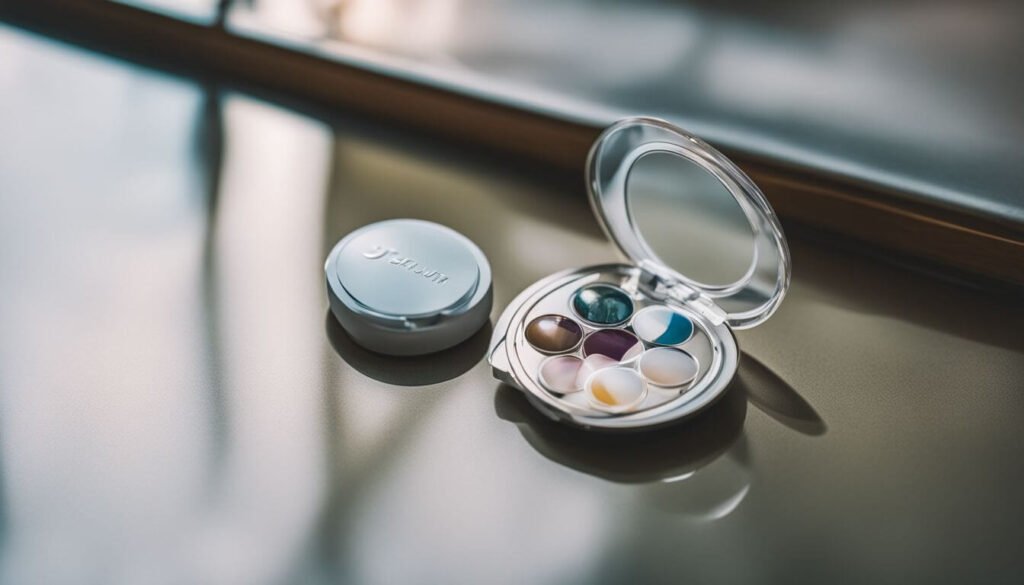
What is the Right Age to Wear Contact Lenses?
So, you’re thumbing through the calendar, wondering if it’s time to swap your kiddo’s specs for contacts, right? Well, strap in because finding that sweet spot age-wise is a bit like Goldilocks—too early and we’re courting chaos; too late and..what were those eye-rolls about again? Let’s dive into the world of optometry whispers and see when it’s just right for the young’uns to make friends with these tiny vision ninjas.
Recommended age range
Kids often start wearing contacts around 8 to 12 years old. This range works well because daily disposable lenses are available for them. But it’s not just about age—the real deal is if they can take care of their lenses right.
By the time kids hit 11 to 14, many are ready for contacts. Eye doctors look at each kid differently to see if they’re up for the task.
Every child is unique, so there isn’t a set age that’s perfect for all kids to start with contact lenses. Some children might be good to go at eight, while others need a little more time.
The key thing is making sure they know how to use and look after their lenses safely and responsibly before jumping in.
Individual eye doctor requirements
Eye doctors look at each child’s case to decide if contact lenses are a good choice. They check the child’s eyes and ask questions about their daily life. It helps them know if the kid can take care of contacts.
Some children might be ready at 8, others not until they’re older.
Your child’s eye doctor will have their own rules for when kids can start wearing contacts. The doctor wants to make sure your kiddo is safe and won’t hurt their eyes. They’ll teach them how to put in and take out lenses and keep them clean.
This way, wearing contacts stays fun and easy for your child!
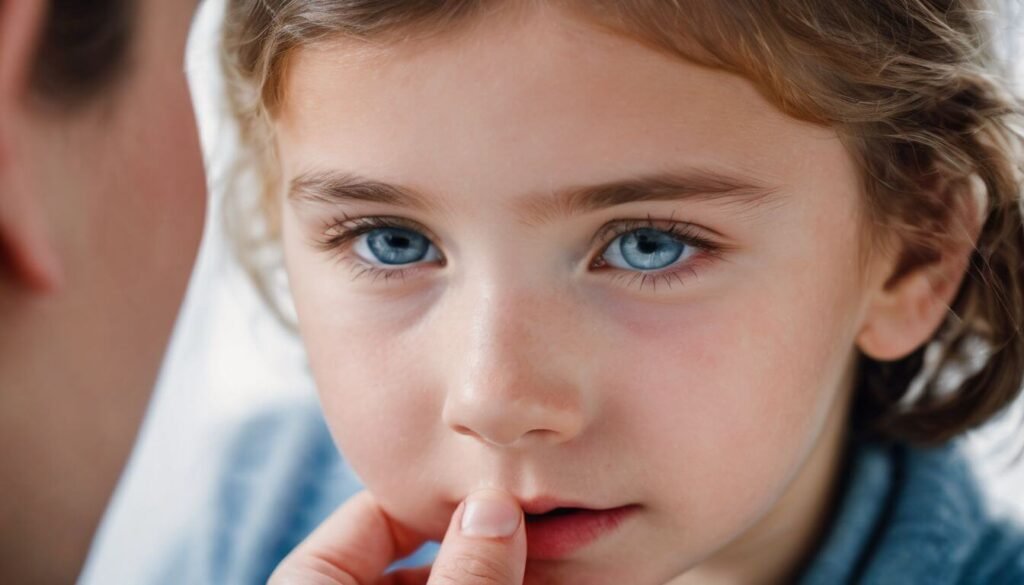
Pros and Cons of Contact Lenses for Children
“Stepping into the world of contacts can be a game-changer for your kiddo—hello, confidence boost and crystal-clear soccer field views! But hold up, it’s not all high-fives and victory dances; with greater vision comes a dash of responsibility—think hygiene routines akin to superhero training.”
Improved vision and self-esteem
Contacts can make a big difference in how kids see things and feel about themselves. With sharp vision, they may do better in school and sports. Kids often love the way they look without glasses, boosting their confidence.
It’s cool seeing them stride into class or run onto the field with that new sparkle of “I got this!” Plus, contacts offer better side vision than glasses; that’s a win for both games and glancing around.
Let’s say your child is ready for contact lenses – it can be life-changing! They get to ditch those frames and enjoy clear sight all around them. And let’s face it: looking good matters when you’re young.
Slipping on contacts might just give your kid that little extra pep in their step, knowing they look awesome and can take on whatever comes their way!
Increased risk of complications
Wearing contacts can be a big step for kids. They need to keep their eyes clean and follow all the rules for safe use. If they don’t, they might get eye problems like infections or even hurt their eyes.
Some doctors think kids under 12 should wait before trying contacts because the risks are higher than the benefits.
Sure, contact lenses offer freedom from glasses, but there’s more to it. Kids must learn how to put them in and take them out right. Also, not keeping lenses clean can lead to dry eye or other troubles.
Children must know how to care for their lenses well so they don’t have these problems!
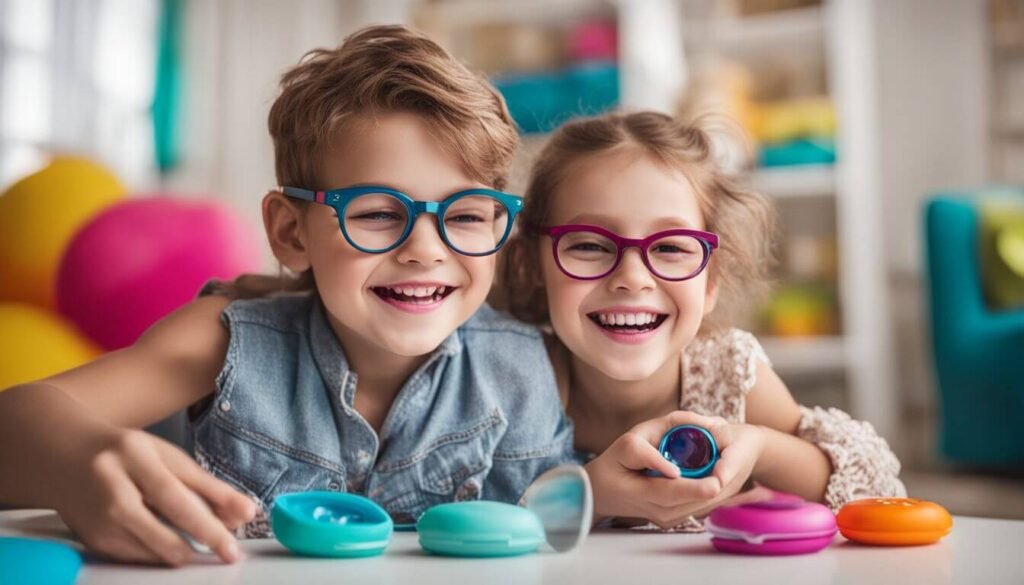
Strategies for Improving Cooperation with Children
Alright, let’s be real; getting kids to cooperate is like herding cats—but with the right strategies, they’ll be handling their contact lenses like pros. It’s all about dialing up that open communication (think more ‘heart-to-heart’ and less ‘lecture mode’) and making sure those hygiene habits become as second nature as streaming their favorite shows.
Open communication
Talking to your kids plays a huge part in helping them wear contacts. Tell them what wearing lenses means, like how they must clean and care for their contacts every day. Be honest about the good stuff and not-so-good stuff that comes with lens wear.
Kids need to get that wearing contacts is a big deal and they have to be responsible.
You might say something like, “Hey, it’s cool you want contacts instead of glasses. But we’ve got to keep those eyes happy and healthy, so you’ll need to follow some rules.” Keep chats light but clear—this way, kids feel more grown-up and part of the decision-making process.
It also helps if they know they can always talk if there’s an issue or question about their new contact lenses.
Proper hygiene habits
Keeping contact lenses clean is super important for kids. They must wash their hands before they touch their lenses. No shortcuts here! Dirty fingers can spread germs, and that is bad news for eyes.
Kids need to understand this; otherwise, eye problems could show up.
Teach them the right way to put in and take out contacts. Doing it wrong can hurt their eyes or mess up the lens. A good routine helps a lot too—like cleaning contacts every night if they’re not daily disposables.
Tell your child how serious proper lens care is but also make it fun so they’ll stick with it!
Rewards and encouragement
Patting kids on the back can work wonders, especially when they’re learning to use contact lenses. Imagine your child popping in their contacts all by themselves – that’s a big deal! A high-five or maybe even picking out a cool case for those new lenses could make them feel like rock stars.
And it’s not just about making them smile; rewards help build good habits too.
You know, little things—like stickers or an extra story before bed—can go a long way if your kiddo nails the whole clean-and-care routine for their contacts. It shows them you see how hard they’re working and that wearing contacts responsibly is something to be proud of.
Plus, it makes the everyday stuff fun, so putting in those lenses turns into something they actually look forward to!

Important Factors to Consider
When it comes to deciding whether your kiddo should leap to contact lenses, there’s more at play than just age and responsibility. You’ve gotta consider the nitty-gritty—like, can your wallet handle it? Or will insurance swoop in like a superhero with coverage? Sure, those tiny pieces of plastic promise freedom from glasses, but there are real costs tied up in those little lifesavers for your child’s peepers.
Financial needs
Paying for contact lenses can be a big deal. They might cost more than glasses. Some parents worry about this, thinking it’s too much to pay every month or year. But here’s the good news: many times, insurance will help cover the price of contacts for your child.
Now let’s talk about when you have to buy them. You should know that daily disposable lenses are available, and they’re really handy. Your kid can use a fresh pair each day without needing lots of cleaning supplies—which saves money! Sure, some types of contacts might seem pricey at first glance.
Still, in the long run, they could actually be easier on your wallet than you’d think!
Insurance coverage
Hey, let’s chat about insurance for contact lenses. So you’re thinking, glasses are one thing, but what if my kid prefers contacts? Well, good news! Some insurance plans help with the cost.
They might not cover all of it, but every bit helps, right?
Make sure to check your plan or talk with your insurance company. Ask them how they can help pay for contact lenses or eye exams. It could be a real budget saver! Plus, think of the smiles when your child feels great about their new look and clear vision—totally worth looking into that coverage!
Cost of contact lenses
Let’s talk dollars and sense—contact lenses aren’t just a commitment to your child’s eye health, but to your wallet too. Here’s the deal: the cost can vary as much as your kid’s taste in music, from “that’s affordable” to “yikes, that’s a car payment!” So, buckle up, we’re diving into the financial fun of contact lenses with a handy table to break it down for you.
| Type of Contacts | Estimated Annual Cost | Factors Influencing Cost |
|---|---|---|
| Daily Disposables | $500 – $700 | Convenience, no need for cleaning solutions |
| Weekly or Monthly Disposables | $300 – $600 | Balance between cost and comfort; replacement and care solutions needed |
| Extended Wear | $250 – $500 | Longer use but higher risk of complications, requires regular cleaning |
| Rigid Gas Permeable (RGP) | $100 – $300 | Longer lifespan but may have an adjustment period for comfort |
| Specialty Lenses (Astigmatism, Multifocal, etc.) | $500 – $1000+ | Customized for specific needs; higher price point |
Remember, these numbers aren’t set in stone; think of them as a ballpark—like where you’d catch a baseball game, not the exact seat you’re warming. Insurance might slide into home plate and cover part of the cost, so check your policy. And hey, don’t forget the hidden costs like regular eye exams and possibly a few extra lenses because, let’s face it, kids can be a whirlwind of lost and found.

Alternatives and Complementary Solutions
So you’re pondering whether little Johnny or Suzy should join the contact lens club, huh? Well, before we dive into tender-aged eyeballs and silicon hydrogel adventures – let’s chat about some ace alternatives and nifty complementary solutions that might just be the perfect fit (or should I say ‘focus’?) for your kiddo’s peepers.
Stick around, because there’s a whole world beyond those chic specs! 🤓🌟.
Glasses and Vision Therapy
Glasses are a trusty choice for kids who need vision correction. They’re easy to use and can be super stylish—kids love picking out their own frames! Plus, they help children see clearly which can make a huge difference in school and sports.
Now, let’s talk about vision therapy—it’s like exercises for your eyes. It helps them get stronger and work better together. Picture this: playing special games or doing activities that teach your eyes to focus the right way.
Some kids might do both—wear glasses and go to vision therapy—to keep their peepers in tip-top shape!
Advances in Contact Lens Technology
Kids today have it so cool, even with contact lenses! New technology means contacts are way better than they used to be. They’re not just for seeing clearly—they come in different types that can protect young eyes from the sun and make sure their eyes stay healthy.
Imagine contacts that you throw away after one day. Yup, they exist now! Daily disposable lenses mean kids don’t have to clean them every night. This is super handy and helps prevent eye problems from dirty lenses.
Plus, these new kinds of contacts are soft and comfy—and that’s a big deal when you’re wearing them all day at school or playing around.
So for parents thinking about getting contacts for their children—things are looking up (and super clear!). With all these neat options, finding the right fit could be easier than ever before.
Just check with an eye doctor to see what’s best for your kiddo!
Conclusion
So, when’s the best time for your kiddos to start wearing contacts? Think about their habits and how well they handle responsibilities. Remember, it’s not just about how old they are – it’s whether they’re ready for the task.
Chat with their eye doctor and see what makes sense for your child. And hey, if you decide now’s the time.. go for it! It could be a game-changer for them; just make sure you’re all in on keeping those peepers safe!

FAQ
Q: What is the minimum age for contacts, according to eye care professionals?
A: Eye care professionals generally agree that there isn’t a strict minimum age for contacts. The decision is more about whether your child is responsible enough to wear and care for contact lenses as directed. It’s essential to have an eye exam and consult with an optometrist to determine whether contact lenses are right for your child.
Q: What are the benefits of contact lenses over glasses?
A: The benefits of contact lenses include improved peripheral vision, which is not restricted by frames as with glasses. Contacts also stay in place, making them a preferable option for sports and physical activities. Additionally, many people find that switching to contact lenses boosts their confidence and comfort, as they don’t have to worry about the appearance or feel of wearing glasses.
Q: How do I know if my child is ready to start wearing contacts?
A: Determining whether your child is ready to start wearing contact lenses involves assessing their ability to handle and care for the lenses properly. This includes regularly cleaning and storing the lenses, as well as following the eye doctor’s recommendations on wear time. If your child is capable of managing these tasks, they may be ready for the switch from glasses to contact lenses.
Q: What should be included in the first eye exam before getting contacts?
A: The first eye exam before starting contact lens wear should include a thorough evaluation of your child’s vision correction needs and eye health. The optometrist will assess whether contact lenses are a suitable option and discuss the wear and care involved. Additionally, a contact lens fitting may be performed to ensure the correct lens type and size for your child’s eyes.
Q: Can wearing contacts too early damage eyes?
A: When properly prescribed by an eye care professional and with proper lens care, wearing contact lenses does not cause damage, regardless of age. The key is ensuring that your child follows the optometrist’s guidelines for wear and care. It’s also important to have regular follow-up visits to monitor your child’s eye health and vision correction needs.
Q: What are the most important lens care tips for young wearers?
A: The most important lens care tips include washing hands thoroughly before handling lenses, using contact lens solution (not water) for cleaning and storing lenses, not sleeping in contacts unless specifically advised by an eye doctor, and replacing the lenses as recommended. It’s crucial to follow all instructions from the eye care professional for safe contact lens wear.
Q: Is a lens fitting necessary for all children considering contact lenses?
A: Yes, a lens fitting is a critical step for any child considering contact lenses. During a contact lens fitting, the optometrist measures the eyes to determine the right curvature and diameter for the contact lenses. This ensures optimal comfort, vision correction, and eye health. The eye doctor may also provide trial lenses to ensure a good fit before making a final prescription.
Q: How often should my child have an eye exam if they wear contact lenses?
A: Children wearing contact lenses should have an eye exam at least once a year or as recommended by their eye care professional. These exams are crucial for monitoring the child’s vision, ensuring the contact lenses are still fitting well, and checking for any signs of eye health issues. Regular check-ups help maintain optimal eye health and comfort in contact lens wear.



